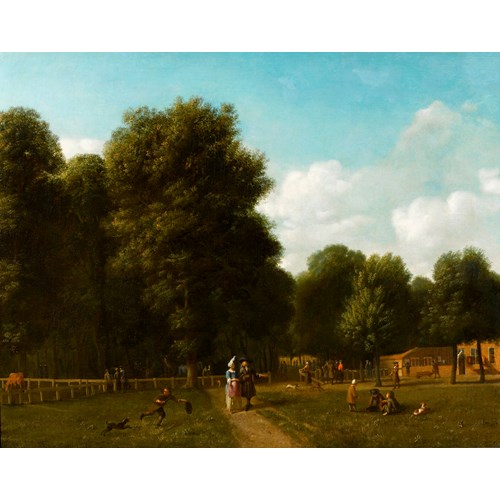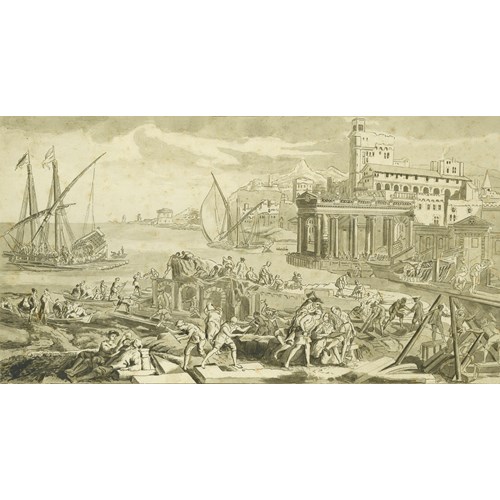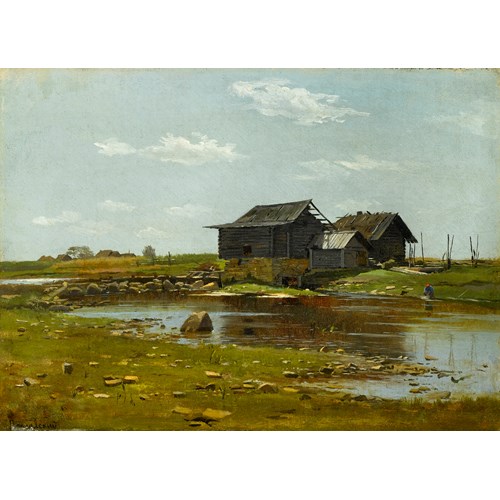Marketplace
The Four Seasons
Louis-Gabriel Blanchet
The Four Seasons
Date 1759
Epoque 1750-1850, 18th century
Origine France, Italy
Medium Oil on panel
Dimension 22 cm (8⁵/₈ inches)
‘Therefore all seasons shall be sweet to thee
Whether the summer clothe the general earth
With greenness, or the redbreast sit and sing
Betwixt the tufts of snow on the bare branch
Of mossy apple tree...’
- Samuel Taylor Coleridge, Frost at Midnight (1798)
Each portrait in this set of four, depicts the vibrant paraphernalia of the four seasons: spring, summer, autumn and winter. Summer is the first season of the four tondi to be illustrated and with the radiant promise of sun and plenty after a long winter, the putto-esque figure is painted with delicate ears of corn inter-woven with her blonde curls. In her arms she clasps a golden bundle of freshly scythed corn, the positioning of which frames her rosy face with its wistful smile. Summer’s dimpled hands and child-like features stand in remarkable contrast to the mature figure that Louis-Gabriel Blanchet painted ten years later, Allégorie de l’Été / Allégorie de l’Hiver (Private Collection). It is possible that he used this tondo portrait as an initial basis for it.
Spring is the second of the four portraits, and an intensely arresting child gazes out with an abundance of exotic flowers pressed to her chest. The flowers, denoting spring, could be anemones. The sinuous curves, created by both her blonde curls and the blue ribbon woven through them is a characteristic distinctive of the Rococo style that Blanchet absorbed both from France, as well as from his adopted home of Italy. The pastel shades of the clothes worn by at least three of his sitters are also a unique feature of French Rococo artists.
The child representing autumn clutches a bunch of succulent, dark purple grapes and, with vine tendrils playing about his hair, bears a significant resemblance to the young Bacchus, Roman god of wine. Autumn was commonly the time for the grape harvest and festivals celebrating the ‘grape-gatherer’, Bacchus were widespread.
Autumn gives way to winter in the last of the tondi: a figure, wrapped tightly in a fur-trimmed scarlet coat with a tasselled cap fitting snugly around his head, attempts to ward off the cold. In stark contrast to the other scantily clad putti, winter is suggested too by the figure’s shiny nose and ruddy complexion. As in the other three paintings where each season can be identified by various props, ‘winter’ poses with a glazed ochre urn filled with glowing embers to keep him warm. In subject matter and composition, this portrait is similar to the second of the twinned allegories, Allégorie de l’Été / Allégorie de l’Hiver.
Principally a painter of portraits, it seems only natural that Blanchet should use people as the modus operandi for his allegorical portrayals. On his arrival in Rome he enjoyed the patronage of such distinguished persons as Nicolas Vleughels, Director of the Academie de France and the Duc de Saint-Aignan, who was also the ambassador to the Holy See. Under their auspices. Blanchet was certainly influenced by the prevailing Italian style as the putti-like appearance of these four figures demonstrates. He was fond of painting allegories and some of his works bear similarities to that of his Roman contemporary Pompeo Girolamo Batoni (1708-1787).
Whether the summer clothe the general earth
With greenness, or the redbreast sit and sing
Betwixt the tufts of snow on the bare branch
Of mossy apple tree...’
- Samuel Taylor Coleridge, Frost at Midnight (1798)
Each portrait in this set of four, depicts the vibrant paraphernalia of the four seasons: spring, summer, autumn and winter. Summer is the first season of the four tondi to be illustrated and with the radiant promise of sun and plenty after a long winter, the putto-esque figure is painted with delicate ears of corn inter-woven with her blonde curls. In her arms she clasps a golden bundle of freshly scythed corn, the positioning of which frames her rosy face with its wistful smile. Summer’s dimpled hands and child-like features stand in remarkable contrast to the mature figure that Louis-Gabriel Blanchet painted ten years later, Allégorie de l’Été / Allégorie de l’Hiver (Private Collection). It is possible that he used this tondo portrait as an initial basis for it.
Spring is the second of the four portraits, and an intensely arresting child gazes out with an abundance of exotic flowers pressed to her chest. The flowers, denoting spring, could be anemones. The sinuous curves, created by both her blonde curls and the blue ribbon woven through them is a characteristic distinctive of the Rococo style that Blanchet absorbed both from France, as well as from his adopted home of Italy. The pastel shades of the clothes worn by at least three of his sitters are also a unique feature of French Rococo artists.
The child representing autumn clutches a bunch of succulent, dark purple grapes and, with vine tendrils playing about his hair, bears a significant resemblance to the young Bacchus, Roman god of wine. Autumn was commonly the time for the grape harvest and festivals celebrating the ‘grape-gatherer’, Bacchus were widespread.
Autumn gives way to winter in the last of the tondi: a figure, wrapped tightly in a fur-trimmed scarlet coat with a tasselled cap fitting snugly around his head, attempts to ward off the cold. In stark contrast to the other scantily clad putti, winter is suggested too by the figure’s shiny nose and ruddy complexion. As in the other three paintings where each season can be identified by various props, ‘winter’ poses with a glazed ochre urn filled with glowing embers to keep him warm. In subject matter and composition, this portrait is similar to the second of the twinned allegories, Allégorie de l’Été / Allégorie de l’Hiver.
Principally a painter of portraits, it seems only natural that Blanchet should use people as the modus operandi for his allegorical portrayals. On his arrival in Rome he enjoyed the patronage of such distinguished persons as Nicolas Vleughels, Director of the Academie de France and the Duc de Saint-Aignan, who was also the ambassador to the Holy See. Under their auspices. Blanchet was certainly influenced by the prevailing Italian style as the putti-like appearance of these four figures demonstrates. He was fond of painting allegories and some of his works bear similarities to that of his Roman contemporary Pompeo Girolamo Batoni (1708-1787).
Date: 1759
Epoque: 1750-1850, 18th century
Origine: France, Italy
Medium: Oil on panel
Signature: Two signed and dated ‘L.Blanchet / 1759’ (lower right), all inscribed ‘blanchet a Rome / 24 piese’ (on the reverse).
Dimension: 22 cm (8⁵/₈ inches)
Plus d'œuvres d'art de la Galerie









